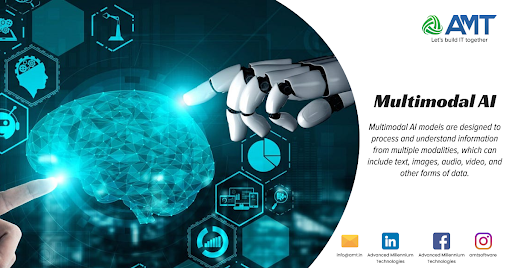Multimodal AI models are designed to process and understand information from multiple modalities, which can include text, images, audio, video, and other forms of data. These models aim to leverage the strengths of different modalities to enhance overall performance and provide a more comprehensive understanding of the input data. Here are some key aspects of multimodal AI models:
- Integration of Modalities:
- Text-Image Fusion: Combining information from text and images can be useful in applications like image captioning, where the model generates a textual description of an image.
- Audio-Visual Integration: Models can learn from both audio and visual data simultaneously, useful in tasks such as video classification or speech-to-text in videos.
- Architectures:
- Transformer-based Models: Large-scale transformer architectures, like GPT (Generative Pre-trained Transformer) and BERT (Bidirectional Encoder Representations from Transformers), have been extended to handle multimodal tasks.
- Cross-modal Pre-training: Models are often pre-trained on large datasets containing multiple modalities before fine-tuning on specific tasks.
- Applications:
- Image and Text Understanding: For tasks like image captioning, visual question answering, and sentiment analysis on images.
- Speech and Text Processing: Useful for tasks such as speech-to-text, where audio information is converted into textual data.
- Datasets:
- Multimodal Datasets: The development of datasets that include multiple modalities is crucial for training and evaluating multimodal models. Examples include COCO (Common Objects in Context) for image and text, or the How2 dataset for speech and text.
- Challenges:
- Data Heterogeneity: Ensuring that the data from different modalities is appropriately aligned and represents coherent information is a significant challenge.
- Model Complexity: Combining multiple modalities often results in more complex models, requiring careful design and optimization.
- Research Trends:
- Continual Advancements: Ongoing research focuses on improving the performance, efficiency, and interpretability of multimodal models.
- Zero-shot Learning: Enabling models to perform tasks with modalities they were not explicitly trained on.
- Examples:
- CLIP (Contrastive Language-Image Pre-training): Developed by OpenAI, CLIP is a multimodal model that can understand images and text in a unified way.
- ViT (Vision Transformer): Initially designed for image classification, ViT has been extended for multimodal tasks.
Here are some additional trends and examples:
- Generative Models:
- Multimodal Generative Adversarial Networks (GANs): GANs have been extended to handle multiple modalities simultaneously, allowing the generation of content such as images conditioned on text descriptions.
- Industry Applications:
- Healthcare: Multimodal models can be applied in healthcare for tasks like medical image analysis, where both visual and textual information can be crucial for accurate diagnosis and treatment planning.
- Autonomous Vehicles: Integration of information from various sensors, such as cameras and LiDAR, along with textual data, can enhance the capabilities of autonomous vehicles.
- Attention Mechanisms:
- Cross-Modal Attention: Attention mechanisms, popularized by transformer architectures, play a crucial role in allowing models to focus on relevant information across different modalities.
- Ethical Considerations:
- Bias and Fairness: As with any AI system, there’s a growing awareness of the potential biases in multimodal models, and researchers are working on addressing these issues to ensure fair and unbiased performance across different demographic groups.
- Real-Time Processing:
- Efficiency Improvements: Continued efforts are being made to optimize multimodal models for real-time processing, making them more practical for applications like video analysis and live streaming.
- Collaborative Learning:
- Learning Across Modalities: Research explores how models can learn and benefit from multiple modalities collaboratively, improving overall performance and generalization.
- Interactive Systems:
- Human-Computer Interaction: Multimodal AI is being integrated into interactive systems, allowing more natural and intuitive interactions between humans and machines through speech, gestures, and visual cues.
- Customization and Transfer Learning:
- Task-specific Adaptation: Models are being designed to adapt to specific tasks while leveraging knowledge from pre-training on diverse multimodal data.
- Transfer Learning: Techniques are being developed to transfer knowledge from one multimodal task to another, reducing the need for extensive task-specific labeled data.
Above is a brief about Multimodal AI. Watch this space for more updates on the latest trends in Technology.
